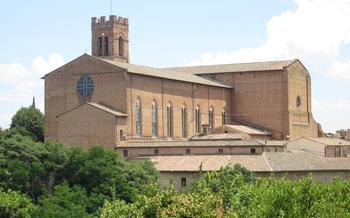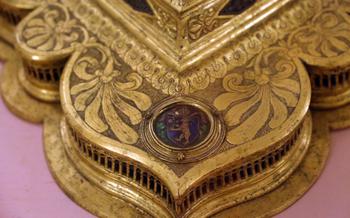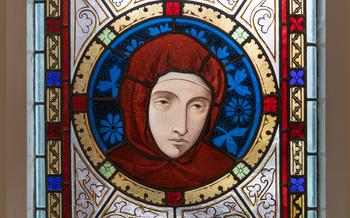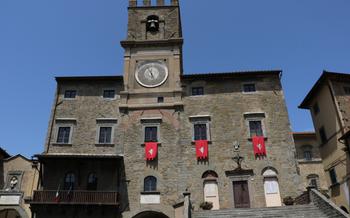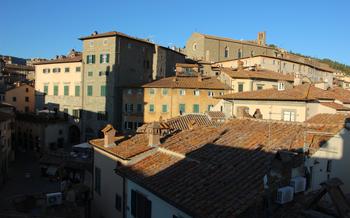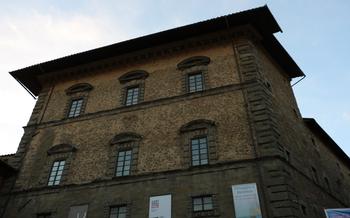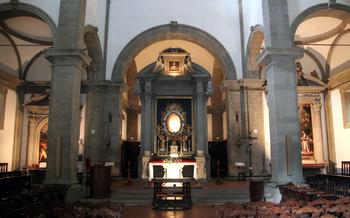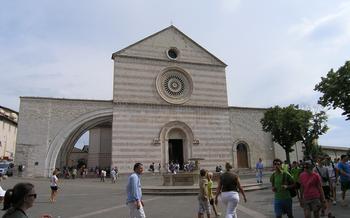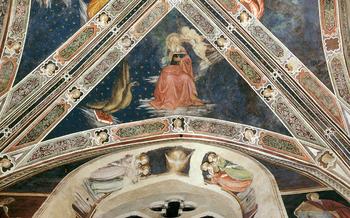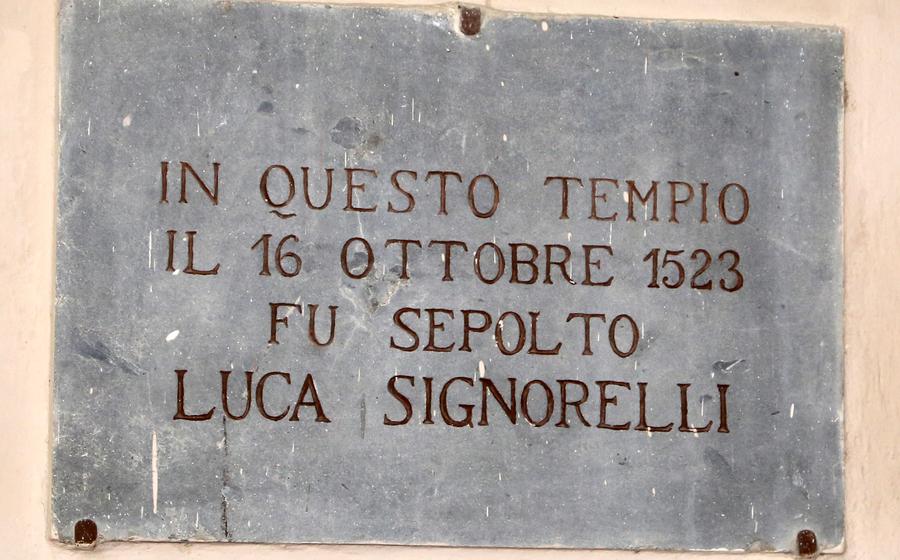
Chiesa di San Francesco
- History of the Chiesa di San Francesco
- Exterior of the Church
- Interior of the Church
- Museo Diocesano
- Cappella di Santa Margherita
- Cappella del Sacro Cuore
- Altars and Statues
- Sacristy
- Cloister
- Events and Activities
- Visiting Tips
- Getting to the Chiesa di San Francesco
- Insider Tip: A Hidden Gem in the Cappella del Sacro Cuore
History of the Chiesa di San Francesco
The Chiesa di San Francesco stands as a testament to the enduring influence of the Franciscan Order in Cortona. Its construction began in 1245, driven by the devotion of the local community to the ideals and teachings of Saint Francis of Assisi. The church's design reflects the architectural style prevalent in the 13th century, characterized by its simplicity, functionality, and adherence to the principles of the Franciscan Order.
The construction of the church was completed in 1266, and it quickly became a central hub of religious and spiritual life in Cortona. The Franciscan friars, known for their commitment to poverty, charity, and humility, played a crucial role in shaping the cultural and religious identity of the city. The church served as a place of worship, contemplation, and community gathering, fostering a deep connection between the people of Cortona and the Franciscan Order.
Exterior of the Church
The Chiesa di San Francesco boasts an impressive facade that showcases the architectural style prevalent in the 13th century. Constructed using local sandstone, its simplicity adds to its charm, focusing attention on the magnificent rose window above the main entrance. The intricate stone carvings surrounding the window depict scenes from the life of St. Francis, adding depth and symbolism to the facade.
The bell tower, an iconic landmark of Cortona, rises elegantly from the church's side. Its slender structure and arched windows create a harmonious balance with the rest of the building. At the top, a series of merlons adds a touch of medieval grandeur to the overall design.
The exterior of the church is further embellished with various artistic elements, including statues and bas-reliefs. One of the most notable pieces is a 14th-century bas-relief depicting the Madonna and Child, situated above the side entrance. The delicate carving and serene expressions of the figures capture the essence of the church's dedication to the Franciscan Order.
Interior of the Church
The interior of the Chiesa di San Francesco showcases a harmonious blend of architectural elements and artistic masterpieces. Visitors are greeted by a spacious nave, featuring a series of elegant columns that divide the space into three aisles. The nave is characterized by its high vaulted ceiling, which adds to the sense of grandeur and luminosity.
The aisles are embellished with intricate frescoes and paintings, depicting biblical scenes and the lives of saints. Notable among these is the 14th-century fresco cycle by Pietro Lorenzetti, which narrates the story of the life of Saint Francis. The vibrant colors and expressive figures of these frescoes captivate visitors and transport them back in time.
Museo Diocesano
Enclosed within the hallowed walls of the Chiesa di San Francesco lies the Museo Diocesano, a treasure trove of sacred art and ecclesiastical artifacts. This museum is a testament to Cortona's rich religious heritage, showcasing a remarkable collection that spans centuries of artistic devotion. Among the highlights of the museum's collection are exquisite paintings, intricate sculptures, and precious liturgical objects that provide a glimpse into the town's spiritual past.
Visitors to the Museo Diocesano are greeted by an array of captivating artworks, including paintings by renowned Tuscan masters such as Pietro Lorenzetti and Luca Signorelli. Their works depict biblical scenes and religious figures with remarkable skill and artistry, inviting viewers to contemplate the divine and the sacred. Alongside these paintings, a collection of sculptures crafted from wood, stone, and bronze adorn the museum's walls, each piece a testament to the artisanship and devotion of their creators.
The Museo Diocesano offers a unique opportunity to delve into the religious history of Cortona and appreciate the artistic expressions of faith that have shaped the town's cultural identity. With its curated collection of sacred treasures, the museum provides visitors with a profound and awe-inspiring experience that enriches their understanding of the deep connection between art and spirituality in this beautiful Italian town.
Visiting Hours and Admission Fees: - Opening Hours: Tuesday to Sunday, 10:00 AM to 5:00 PM - Admission Fee: Adults €5, Children (6-12 years) €3, Under 6 years: Free - Guided tours are available upon request, offering an in-depth exploration of the museum's collection.
Cappella di Santa Margherita
Located in the right transept of the Chiesa di San Francesco, the Cappella di Santa Margherita (Chapel of Saint Margaret) boasts a rich history and artistic significance within the church. Constructed in the 14th century, it served as the burial place for the noble Casali family of Cortona. The chapel's interior is adorned with stunning frescoes by the renowned Renaissance artist Luca Signorelli, whose works are highly acclaimed for their expressiveness and attention to detail.
The frescoes depict scenes from the life and martyrdom of Saint Margaret of Antioch, a young woman who remained steadfast in her Christian faith despite facing persecution and torture. Signorelli's artistic mastery is evident in the vibrant colors, intricate compositions, and lifelike portrayal of the characters. These frescoes have become a major attraction for art enthusiasts, drawing visitors from around the world to admire Signorelli's exceptional craftsmanship.
In addition to the frescoes, the Cappella di Santa Margherita also features a beautifully crafted altar and a series of decorative elements that contribute to its overall grandeur. The chapel serves as a testament to Cortona's rich artistic heritage and the enduring influence of the Franciscan Order in the city's cultural and religious landscape.
Cappella del Sacro Cuore
The Cappella del Sacro Cuore is another noteworthy chapel located within the Chiesa di San Francesco. It is situated off to one side of the church, offering a separate and contemplative space for visitors. The chapel's name, which translates to Chapel of the Sacred Heart, suggests its dedication to the devotion of the Sacred Heart of Jesus.
One of the highlights of the Cappella del Sacro Cuore is its impressive stained glass windows, which depict various religious scenes and figures. The rich, vibrant colors of the glass create a beautiful play of light within the chapel, enhancing its spiritual atmosphere. The intricate details and artistry of the stained glass windows are a testament to the skill and craftsmanship of the artisans who created them.
In addition to the stained glass windows, the chapel features other artistic elements that contribute to its unique character. The walls are adorned with frescoes and paintings, some of which date back to the Renaissance period. These works of art depict various religious themes and stories, adding to the chapel's spiritual significance and providing visitors with a visual feast.
The Cappella del Sacro Cuore serves as a place of worship and contemplation for many visitors to the Chiesa di San Francesco. Its serene and intimate atmosphere invites visitors to pause, reflect, and connect with their spiritual side. The combination of stained glass windows, frescoes, and paintings creates a visually captivating space that enhances the overall experience of visiting this historic church.
Altars and Statues
The main altar inside the Chiesa di San Francesco is a stunning example of Renaissance artistry. Crafted from intricate marble, the altar features a magnificent altarpiece depicting the Madonna and Child surrounded by saints and angels. The craftsmanship and attention to detail in the sculptures are breathtaking, leaving visitors in awe of the artistic prowess of the era.
The side altars, though smaller in scale, are no less impressive. Each altar is dedicated to a different saint or religious figure, and they are adorned with beautifully carved statues and paintings. The Altar of the Immaculate Conception is particularly noteworthy for its delicate marble sculpture of the Virgin Mary, while the Altar of St. Anthony of Padua showcases a poignant painting of the saint surrounded by his followers.
Interspersed throughout the church are various statues of saints, apostles, and angels. These sculptures, crafted from marble, wood, or terracotta, bring a sense of realism and devotion to the sacred space. Each statue has its unique artistic style and historical significance, adding to the rich tapestry of the church's interior.
Sacristy
The sacristy of the Chiesa di San Francesco is located adjacent to the main altar and serves as a repository for sacred vessels, liturgical vestments, and other religious artifacts used during religious ceremonies. It is a small but historically significant space that has been carefully preserved over the centuries.
The sacristy features a series of notable features that contribute to its unique character. Its walls are adorned with intricate frescoes depicting religious scenes, each one telling a story from the Bible or the lives of saints. These frescoes are believed to date back to the 14th and 15th centuries and showcase the artistic talents of local fresco painters.
Another highlight of the sacristy is its collection of liturgical objects and artifacts. These include ornate chalices, reliquaries, and processional crosses, many of which are crafted from precious metals and gemstones. These objects offer a glimpse into the rich history of the church and its role as a center of religious devotion in Cortona.
Visiting the sacristy provides an opportunity to delve deeper into the spiritual and historical legacy of the Chiesa di San Francesco. It is a sacred space that invites contemplation and reflection, allowing visitors to appreciate the intricate details and craftsmanship that have been lovingly preserved within its walls.
Cloister
The Chiesa di San Francesco also boasts a charming cloister, accessible from the interior of the church. Constructed in the 14th century, this tranquil retreat invites visitors to step into a serene oasis of peace and contemplation. The cloister's courtyard features a well-maintained garden, providing a picturesque backdrop for moments of reflection and appreciation of nature's beauty.
Architecturally, the cloister showcases a harmonious blend of Gothic and Renaissance styles. Its elegant arches, intricate columns, and decorative details create a captivating visual experience. The cloister's serene atmosphere makes it an ideal spot to escape the hustle and bustle of city life and immerse oneself in the tranquility of the sacred space.
Events and Activities
The Chiesa di San Francesco is not only a place of worship but also a hub for cultural and artistic events. Regular religious services, including masses and special ceremonies, take place throughout the week, offering visitors an opportunity to immerse themselves in the spiritual atmosphere of the church.
Beyond religious services, the church hosts a variety of special events and concerts throughout the year. These events showcase the church's remarkable acoustics and provide a platform for local artists to display their talents. From classical music concerts to choral performances, the church's events calendar is diverse and caters to a wide range of interests.
For those seeking a truly immersive experience, attending a special event or concert at the Chiesa di San Francesco is highly recommended. The combination of stunning architecture, sacred ambiance, and talented performances creates a truly unforgettable experience. Visitors are advised to check the church's website or inquire locally for information on upcoming events and schedules.
Visiting Tips
Visiting the Chiesa di San Francesco is a must-do activity in Cortona, and here are some useful tips to enhance your experience:
-
Recommended Time to Visit: For a serene and uncrowded atmosphere, plan your visit early in the morning or late in the afternoon. The church is open during daylight hours, but the best time to admire its beauty is when the natural light streams through the windows, casting a magical glow on the interior.
-
Dress Code: As a sacred space, the Chiesa di San Francesco requires visitors to dress appropriately. Avoid shorts, tank tops, or revealing clothing out of respect for the religious significance of the place.
-
Photography: Photography is generally permitted inside the church, but using a flash is prohibited to preserve the integrity of the artworks. Take this opportunity to capture the stunning frescoes, sculptures, and architectural details that make the church a visual masterpiece.
Getting to the Chiesa di San Francesco
The Chiesa di San Francesco is conveniently located in the historic center of Cortona, making it easily accessible on foot. From the Piazza della Repubblica, the main square of the city, take Via Nazionale towards the east. After about 500 meters, you will find the church on your left, situated along Via San Francesco.
If you prefer to use public transportation, you can take the local bus line that stops near the church. The bus stop is located along Viale Matteotti, and you can catch the bus from various points in the city.
For a more immersive experience, consider exploring Cortona on foot. The city's charming streets and alleyways offer a glimpse into its rich history and culture. As you make your way to the Chiesa di San Francesco, take the opportunity to admire the medieval architecture, visit local shops, and savor the delicious Tuscan cuisine at one of the many restaurants along the way.
Insider Tip: A Hidden Gem in the Cappella del Sacro Cuore
Take a closer look at the Cappella del Sacro Cuore, located in the left transept of the church. This chapel holds a hidden gem that often goes unnoticed by visitors. Behind the altar, you'll find a small door that leads to a secret staircase. Ascend the stairs to discover a hidden room, once used by the monks for meditation and prayer. The room offers a unique perspective of the chapel and a serene atmosphere that invites contemplation and reflection.
Here, you can immerse yourself in the tranquility of the sacred space and connect with the spiritual essence of the Chiesa di San Francesco. It's a hidden gem that adds another layer of intrigue and spirituality to your visit to this remarkable church.
